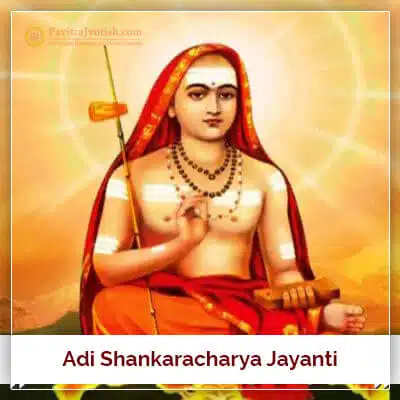Adi Guru Shankaracharya
Published On : April 6, 2024 | Author : Astrologer Pt Umesh Chandra Pant
Lord Shri Adi Guru Shankaracharya Jayanti
Lord Adi Guru Shankaracharya Jayanti: he is the soul and supreme pillar of the Hindu religion, who rendered a comprehensive structure of Hinduism by solidifying its two aspects; one related to Dvaitvad and the other one related to Advaitvad (non-secondness). Both of these philosophical aspects help people to soar higher and reach their destination. In other words, the philosophies equate with the attainment of the final goal called salvation. Otherwise, the lack of these philosophies would distract people, rendering them into an aimless pursuit of nothingness. According to Shankaracharya, based on the premise of Dvaitvad, a man can build devotions and faith that would eventually constitute a gateway for him to pursue the doctrine ofAdvaitvad. To say otherwise, he propounded the doctrine of idolatry as a doorway to devotions and liberations.
Works he composed include songs and poems dedicated to Shri Ganesha, Shiva, Parvati, Nandi, Kartikeya, Durga, etc. If the religious books, such as Bhavishyottar Purana are to be believed, Lord Shankaracharya was the divine incarnation of Lord Shiva, as Shiva incarnated four of his disciples on earth to institutionalize religions on it, and chose his own form to incarnate as Shankaracharya. In Kerala of Kaladi village, the birth of Shankaracharya happened on 508 BC, according to various pieces of evidence. His birth is largely attributed to the rigorous meditations and worships that his parents (father Shiv Guru and mother Subhadra) observed to please Lord Shiva. Happy and satisfied by the worship, lord Shiva granted them the boon, saying his own divine form would be born as their son. Considering baby Shankaracharya as a gift from Lord Shiva, his parents named him Shankar. Honor Adi Guru Shankaracharya’s Jayanti with devotion, study, and contemplation.
Educations Of Adi Guru Shankaracharya And Becoming Hermit
Adi Shankaracharya, as a prodigious child, soon gained command over Vedas and Vedic learnings, at the age of just 7. By the time he was 8 years old, he became a hermit. His father passed away when baby Shankaracharya was just 3 years old. Being an only child of his parent, obviously, his parent insisted on getting married and settling into domestic life. However, Shankaracharya had proclivity for theism and BrahmaGyandeveloped in him since his childhood.
Therefore, he thought it wise not to indulge in marital life. However, since he didn’t want to worry his mother, he devised a plan. Once, while taking a bath in a river, a crocodile miraculously appeared there and began to drag a foot of Shankaracharya (when he was 8). Seeing his life in danger, his mother panicked. At this, Shankaracharya said if she permitted her to become a hermit, the beast (crocodile) would leave his foot, or else it would eat him. The panic-stricken mother caved in, and granted him the permission, thus prompting baby Shankaracharya to become a hermit. Adi Guru Shankaracharya Jayanti Celebration: A Spiritual Tribute in India.
Pilgrimages And Compositions Of Adi Guru Shankaracharya
Adi Shankaracharya travelled to many religious places on foot. Some of the places he travelled to include Kashi to Badrinath, and the Himalayas, as well as the whole of India. Then he reinforced the foundation of religion, triggering thereby the wave of Hinduism throughout the country. He propounded about Brahma, calling it an everlasting and empirical reality. He called the world illusionary created by Brahma. In other words, the reality of Brahma is unquestionable. Some of the greatest works he composed include Chudamani, Soundarya Lahari, and Bhashya.
Literature Debates Of Adi Guru Shankaracharya
Adi Shankaracharya participated in debates with many erudite and learned scholars across the nation, including Kashi, and from all over the world. His acute logic and profound learning defeated all of the scholars, thereby positioning him on the top among them, thus becoming a unanimous guru of the scholars. He also ended the then quarrel between Shaiva and Shakta, thereby prompting people to understand and accept the infinite power of Brahma. Thus, lord Shankaracharya promoted and solidified communal, religious, and societal unity nationwide and across the world. He lost a debate to Mandan Mishra from Bihar. How come? Because he couldn’t answer the questions (about Kamashastra) posed by Mishra’s wife. Adi Guru Shankaracharya Jayanti: Celebrating Wisdom, Legacy, Spiritual Enlightenment, Reverence.
However, Shankaracharya was bent on finding the answers to those questions and so entered into the body of Amaruka, gained insights into the Kama, and then answered all the questions of Mandan Mishra’s wife (who, by some, is considered in the incarnation of goddess Saraswati). He won the debate. In addition, Shankaracharya also defeated Buddhists in a debate, refusing to accept Buddhism as a religion, which consequently antagonized him with many Buddhist monks. His contributions include setting up monasteries and temples, across India, from North to South, then from East to West in all directions. They are Badrikashram, SringeriPeeth, Dwarika, ShardaPeeth, and Govardhan in Puri. He believed that God exists in dualism, with attributes and without attributes, at the same time. Among the four eras (Yugas), the age, merits and abilities of individuals wane most in the Kali Yuga. Moreover, Kali Yuga is also a period in which the downfall of religious sanctity happens. Someone who sits in one of the Peeths (Ashram) constructed by Shankaracharya is hailed as Shankaracharya.
Shri Adi Guru Shankaracharya Transforming A Poor Brahman Into A Rich
According to a legend, once lord Shankaracharya set out for begging. Coincidentally, he stopped at a house of a very poor Brahman who had nothing with him to give as alms to Shankaracharya. Still, the wife of the Brahman gave him the fruit of amla. While narrating the precarious condition of her household due to abject poverty to Shankaracharya, she couldn’t control her tears. The plight of the Brahman family pitied the heart of Shankaracharya, who, out of mercy, turned every amla kept in the house of Brahman into gold. Suddenly, there was a heap of gold inside the house. Thus, there are so many tales of kindness and divine miracles of Shankaracharya being told in various folklores and religious books.
Don’t Forget to Read:
Lord Parshuram Jayanti and Shri Mahavir Jayanti








